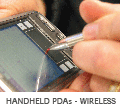Ethernet
Introduction
Ethernet is a widely used wired networking system which consists of a number of physical media and standard frame and addressing protocols layered on top of the media. Ethernet is defined in the IEEE 802.3 standard.
Ethernet started as 10Mbit links over a shared coaxial cable. This made sense when network equipment was expensive. As the cost of this equipment has come down, star-topology twisted pair networks have become dominant. With these, each device has its own private cable back to an Ethernet switch. This offers higher performance, particularly as data rates have moved to 100Mbps and even 1000Mbps.
The addressing system used by the Internet is defined by Ethernet, and Ethernet is the main means by which data is moved around LANs. For higher performance servers, fiber-optic cable is used instead of twisted pair copper.
On top of the physical Ethernet a protocol layer called TCP/IP is generally used. This provides a reliable transport protocol for transmitting data from one device (at a given IP address) to another.
End User Applications
Ethernet is used in a huge range of network devices such as switches and routers. It is also commonly available in printers, computers and network cameras. For ARM, Ethernet has become a very low cost technology with many embedded ARM devices providing at least a MAC interface built in.
Bluewater Systems Experience
Bluewater has used Ethernet in most projects. It is a core feature in all Snapper modules and is a key enabler of application development. While it is generally included in all development boards, it is often omitted from the final product to reduce cost.
Bluewater has used the SMSC single chip Ethernet devices. However ARM Ethernet-enabled microcontrollers have recently become available with the Ethernet MAC built in (such as Snapper CL15 / Cirrus Logic EP9315 and Bigeye / Atmel AT91SAM9260). Where this is not available, the Davicom DM9000A is often used as it is smaller than the SMSC part and consumes less power. In any case Ethernet is a very common ARM feature.
The DDS XM-100 uses Ethernet to allow data to be distributed to a network controller, either encrypted over the Internet, or over a private IP network.
Ethernet on Rig 200
All Snapper modules support Ethernet, in the ARM micro or in an included Ethernet chip. Rig 200 includes an 10/100BaseT Ethernet port for network connection. This includes two LEDs which indicate activity and link status. Power over Ethernet is also provided (see Power_over_Ethernet).




